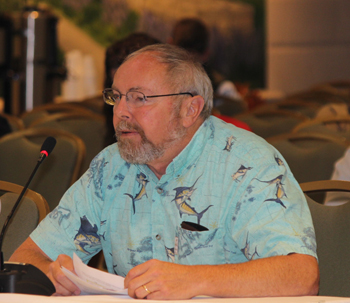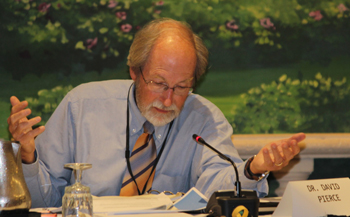Paying to Be Watched
Fishermen Dolefully Eye Monitoring Costs
by Laurie Schreiber

Portsmouth, New Hampshire Fisherman David Goethel. F/V Ellen Diane. “The impact on human communities is very large and it’s essentially the extermination of some of these communities.”Fishermen’s Voice file photo
PORTSMOUTH, N.H.—Not surprisingly, the potential costs to be paid by fishermen for a fishery monitoring program, of one type or another, was a big concern during the New England Fishery Management Council’s (NEFMC) discussion in January of the proposed Industry-funded Monitoring Omnibus Amendment.
“The 10,000-foot view taken with this amendment is like being on a sailing ship in uncharted waters with no lookout posted,” said David Goethel, owner/operator of fishing vessel Ellen Diane. “You’re sailing into the shoals, and no one seems to have the sense that you’re about to run aground. Not one fishery will be economically viable if this is put in place. Not whiting, herring, groundfish, lobster, shrimp—you name it. Small boats can’t afford the costs. I don’t think medium boats can. If the council’s intention is to eliminate small boats in small communities, keep going….The impact on human communities is very large and it’s essentially the extermination of some of these communities.”
The proposed amendment, in development since 2014, would apply to all New England and Mid-Atlantic plans, and would allow NEFMC and the Mid-Atlantic Fishery Management Council to implement programs with available federal funding. It would establish a standardized structure for new industry-funded programs and would not impact industry-funded programs already in place, including groundfish at-sea monitoring and scallop observer programs.
The types of monitoring are human observers, under the National Marine Fisheries Service’s (NMFS) Northeast Fisheries Observer Program (NEFOP) and At-Sea Monitoring Program; electronic monitoring; and portside sampling.
The proposed amendment would split costs between NMFS and the industry. NMFS would handle facilities and labor for training and debriefing, gear, certification, vessel selection, data processing and compliance and safety liaison. Industry w ould handle program management and provider overhead, salary and per diem for training and debriefing, equipment, deployments and sampling, and all other costs.
Cost estimates break down as follow:
• NEFOP observer: NMFS pays $479 per sea day; industry pays $818 per sea day.
• At-Sea monitor: NMFS pays $530 per sea day; industry pays $710 per sea day.
• Electronic monitoring: In year 1, NMFS pays $36,000 in startup plus $97 per sea day; industry pays $15,000 in startup + $326 or $187 per sea day. Just the sea day cost applies in subsequent years.
• Portside sampling: NMFS pays $479-530; industry pays $5.12 or $3.84 per metric ton. $5.12 includes administrative costs and applies to all trips; $3.84 removes does not include administrative costs and applies to 50 percent of trips.
The amendment has a second purpose, to consider monitoring coverage targets for the herring and the mackerel, squid, and butterfish fisheries. According to NEFMC, additional monitoring is necessary in those fisheries to improve the accuracy of landings and discard estimates and estimate the catch of incidental species for which catch caps apply (i.e., the river herring/shad and haddock catch caps).

David Pierce, MA DMF, Director. “Collectively we have to be more vigilant about what this really means for the actual costs of electronic monitoring.” Fishermen’s Voice file photo
NEFMC member David Pierce wanted to know if electronic monitoring could end up being more expensive to fishermen than human monitors, because fishermen will have to have their EM cameras on throughout operations.
“I highlight this because in conversations I’ve had with groundfish fishermen, they’ve expressed alarm… that electronic monitoring will be more expensive than at-sea monitoring,” Pierce said. “Collectively, we have to be more vigilant about what this really means for the actual costs of electronic monitoring, which I favor, but I pull back a little bit the more I learn about….the total costs to the individual fisherman.”
NEFMC members said they were concerned about the cost not only of collecting data but processing data.
“Cost is a big concern,” said NEFMC member Mary Beth Nickell-Tooley, who calculated that a human monitor on a three-day trip to Georges Bank would cost $2,100, while electronic monitoring combined with shoreside monitoring would cost $2,500. Nickell-Tooley advocated for a pilot program to work out the issues.
NEFMC member Ellen Goethel also said she was concerned about potential costs. She said the cost of portside monitoring already in place for groundfish sectors was higher than $5.12 per metric ton, and varied by sector.
“I find that number is completely off,” Goethel said. “We’re talking hundreds of dollars.” The proposals will “have absolutely no positive impact. It’s a way to structure and tie us into paying for what I feel is a government responsibility. And it’s a way for NOAA to get out of that responsibility, and I find it very, very troubling.”
The question of whether NMFS or the industry pays for the actual review of EM video footage remains to be answered.
However, the $326 includes video collection through the duration of a trip plus 100 percent of video review, and $187 represents the video collected just on haulback and 50 percent video review.
“I’d like to see a statement that says monitoring is a function of the government,” said David Goethel. “It’s not a function of the industry.” Goethel said NOAA should ask Congress to allow NMFS to reallocate funding from other program areas in order to pay for monitoring.
Some speakers raised the question of who would own the data.
“If the industry is paying for it, the industry owns the data,” said David Goethel. “Maybe we can sell it back to NOAA for an administrative fee.”
Ron Smollowitz, of the Fisheries Survival Fund but speaking for himself rather than as the organization’s representative, asked NEFMC to take no action on monitoring. He said that monitoring programs should instedd be developed within each fishery management plan. And he said the proposals under consideration don’t examine other electronic monitoring programs that are less expensive.
“There’s a lot of technology this amendment doesn’t discuss, and what you collect for scallop is very different from groundfish,” Smollowitz said. “So we’re wasting time.”
Ellen Goethel agreed. “It’s locking us into a structure and removing flexibility,” she said.
In the end, NEFMC approved preferred alternatives for public review at hearings this spring. It’s expected the final rule will become effective in December 2016.
